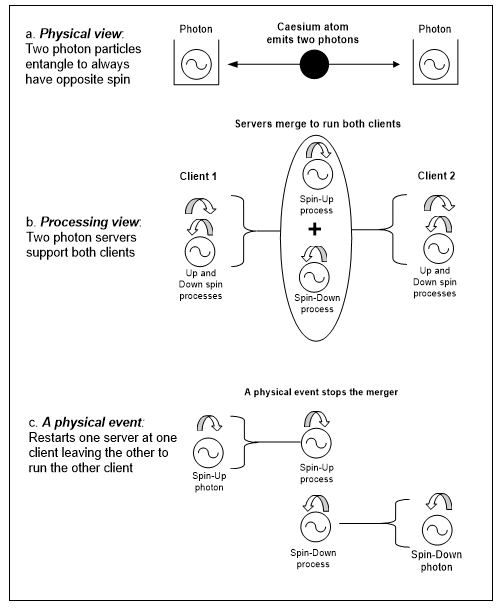Quantum entanglement is another quantum concept with no physical equivalent. It is the unification of quantum entities into one system, so any change instantly affects all of them at any distance. Particles that unify stay together but entangled photons can be light years apart, so entanglement ignores distance entirely.
For example, when a Cesium atom emits two photons in opposite directions, they entangle into one system with net zero spin. Both photons still spin up or down randomly, but if one is measured to be spin up, the other instantly becomes spin down. Experiments show it is always so, but if each photon’s spin is random, how does the other instantly know to be the opposite, at any distance?
Einstein called this spooky action at a distance because it was faster-than-light, and so suggested an experiment to disprove it (Einstein, Podolsky, & Rosen, 1935). When the test was made, based on Bell’s theorem, it supported entanglement, even for photons too far apart to connect at the speed of light (Aspect, Grangier, & Roger, 1982). This was one of the most careful experiments ever done, as befits the ultimate test of quantum theory, and it found that entanglement does occur faster than light, despite Einstein’s objection!
How then can an event at one location affect another at any distance? According to particle physics, it can’t, but the evidence is that it does. If two photons heading opposite ways are separate particles that spin randomly, why can’t both spin up, or both spin down? Quantum theory insists that the initial spin is conserved, but gives no clue as to how. Nature could conserve spin by making one photon spin up and the other down from the start, but apparently this is too much trouble. Instead, it lets both photons spin either way, until one is observed, then instantly adjusts the other to be the opposite, no matter where they are in the universe. Entangled states, now common in physics, have no physical explanation (Salart, Baas, Branciard, Gisin, & Zbinden, 2008).

Particles can’t entangle as quantum theory describes, but processes can. We see two photon particles leaving a Cesium atom (Figure 3.23a) but what if they aren’t? When the Cesium atom restarts two photons at a point physical event, their processing can merge, and this merged processing then just spreads, as it always does. Instead of each photon going its own way, both in effect go both ways. Just as one photon can take many paths and let a later event decide the one it took, the two photons go both ways and let a later physical event decide which went which way.
In network terms, the photon servers simply share the client work, so the wave front going left is run by two servers, as is the one going right (Figure 3.23b). The entangled photons look and act like photons, but each is in effect half spin-up and half spin-down.
Why then is the initial spin conserved? When a physical event occurs the merger ends, as one server restarts, leaving the other to run the other photon with the opposite spin. Which server restarts is random, as it depends on server access, but the result is always two photons with opposite spin. Spin is always conserved because the processing before and after a physical event is always the same (Figure 3.23c).
Entanglement is then non-local for the same reason quantum collapse is, that client-server effects ignore the screen transfer rate we call the speed of light. The speed of a point moving on a screen depends on its refresh rate, but a CPU can change a pixel anywhere directly. Likewise, photon servers ignore how far apart entangled photons are when they act on the screen of our space.
Entangled photons adjust spin instantly because if both photon servers share the work of both wave fronts, they are already in place to handle any physical event. Nothing has to “go” anywhere, as when either server restarts, the other just carries on running the other wavefront, so entanglement doesn’t contradict Einstein’s speed of light limit.
Entanglement also underlies super-conductivity, where many electrons entangle, so every electron is run by all their servers. Electricity then flows with no resistance because, in effect, nothing is moving in a superconductor metal. Bose-Einstein condensates let any number of quantum entities merge in this way. Chapter 6 explores the implications of this unique quantum feature for consciousness.